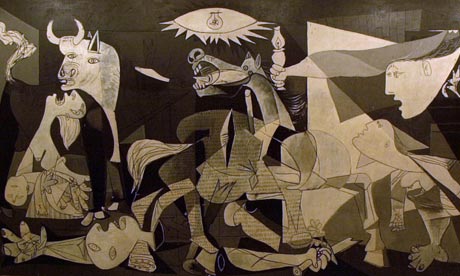
Antonio Banderas as Pablo Picasso? Cool. The casting of the star of Desperado, Tie Me Up! Tie Me Down! and, er, Puss in Boots as the greatest artist of the 20th century is very promising. I mean, he's not simply Spanish but Andalusian. What's more, Banderas was born in Picasso's own birthplace, Malaga. That has to be better than the Welsh Picasso of a previous biopic.
Plausible casting is not the only promising thing about 33 Dias, to be directed by Carlos Saura. It sounds as if it will be a potentially insightful view of an artist at work. For it is all about the making of Guernica – not simply the most powerful political work of art of modern times, but also the outcome of an unusually well-documented creative process.
Photographs of the successive states of Picasso's history painting were taken by his lover, Dora Maar, as it developed. Picasso's drawings and sketch paintings for the screaming horse, the burning building, the broken warrior and Guernica's other component images, together with his progressing conceptions of the overall design of the painting, also survive. As it happens, some are currently on view at Tate Britain.
Guernica was conceived as an explicit response to a contemporary event, the horrific bombing of an ordinary town, a massacre of civilians akin to what is currently taking place in Syria. It was also an attempt to marry the fractured imagery of cubism and the dream art of surrealism with the traditional genre of history painting.
The way Picasso worked on, and recorded his working on, Guernica was itself an engagement with tradition. The idea of the big, planned manifesto painting has a long history in European art – a famous example is Géricault's The Raft of the Medusa. Picasso was born in the 19th century, trained in the academic tradition and believed in the value of such programmatic works when he could sum up a period of insight or deliver a great statement of his vision – he worked on Les Demoiselles d'Avignon in this same way, with heaps of preparatory studies.
Guernica, as a painting of disaster, consciously looks back to Raphael's fresco The Fire in the Borgo. It aspires to a similar grandeur and authority while using the broken revelatory style of cubism to turn reality inside out and communicate, like a punch in your face, the eviscerated horror of a bombed town.
Picasso left not just a great painting, but also a great model of how art can be made – and why it matters. To translate the story of his one-man campaign to change the world into a film is a fine idea. Let's hope the result lives up to Picasso's moral and imaginative heroism.

